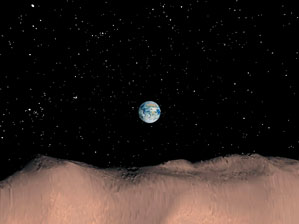
E. de Jong e S.Suzuki/Jpl/Nasa Drawing of an asteroid close to Earth: a collision is possible but the risk is lowE. de Jong e S.Suzuki/Jpl/Nasa
With its almost 4000 inhabitants, the municipality of Itacuruba in Pernambuco State in the São Francisco River valley is ready to become an important place in Brazilian astronomy. By the middle of this year a small robot-driven telescope with a 1 meter diameter reflector is likely to start operating there in the heart of a semi-arid region. Its mission is unusual on Brazilian soil: to establish the physical characteristics and determine the orbit of small celestial bodies, generally asteroids and comets, which are between a few hundred meters and a few kilometers in diameter, and that revolve close to the Earth and present a risk, albeit minimal, of falling onto the planet. “The probability of a collision is very low, but cannot be ignored”, says astrophysicist Daniela Lazzaro, from the National Observatory (NO) in Rio de Janeiro, and coordinator of the work that will be done with the new instrument. “As no one in the southern hemisphere is systematically monitoring these celestial objects, we decided to invest in this research.” The formal name of the project, Impacton (National Observatory Initiative for Mapping and Researching Asteroids that are close to Earth), is a reference to this remote hypothesis with a touch of black humor.
The northeastern locality was chosen to house the telescope, which will be operated remotely from the NO, because of characteristics that are naturally favorable to cosmic observations: 300 clear and cloudless nights a year without rain. The transparency level of the sky, another important requirement, has not yet been fully evaluated, but researchers believe that Itacuruba, the average altitude of which is a little more than 315 meters, will not disappoint. “After the telescope has been operating for two or three years we’ll be certain of the observation potential of the place”, says Daniela. “If the place is not as good as we believe we can transfer the project to another site.” In Itacuruba, the base on which the telescope (German, with Russian optics) and its six meter dome, imported from Australia, will be installed, is ready. The telescope and dome are in Recife and over the next few months will be taken inland. The total cost of setting up the project will be R$ 2 million.
According to NASA’s (American space agency) Near-Earth Objects Project, so far we have knowledge of almost 6000 small celestial bodies orbiting close to the planet. But only around 1000 represent any potential risk of colliding with Earth and causing damage. In order to be a real threat an asteroid or comet needs to be over 150 meters in diameter or be capable of coming to within at least 7.5 million kilometers (0.05 astronomical units) of the Earth. What is the probability of one of these objects colliding with the Earth? Every 100,000 years there’s a little over a 16.5% chance of an object over 1 kilometer in diameter falling to Earth, according to the European Space Agency (ESA). An asteroid this size would open a crater 20 km across and cause the death of millions of people. It’s to follow the trajectory of these possible unwanted visitors for days that Impacton was planned.
Republish
